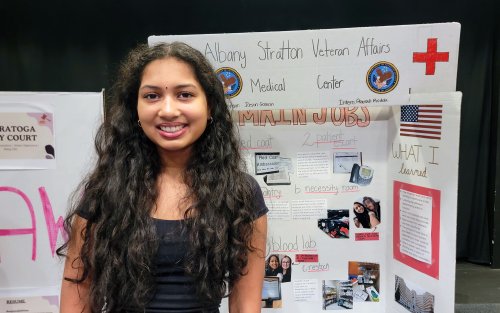Undergraduate Programs
The Physics Department at the University at Albany offers a BS in Physics, minors in Physics and Electronics, as well as combined BS/MS programs:
- A BS in Physics, which opens many doors—graduate studies in Physics, Astronomy, Engineering, etc., as well as career paths in Engineering, Medical fields, Computer Software and Hardware, Science Journalism, Education, Research and Development and many others.
- A combined BS in Physics/MS in Secondary Education, which provides a pathway to teaching in schools.
- A combined BS/MS in Physics, which further increases your qualifications.
Graduate Programs
The Physics Department at the University at Albany offers an MS in Physics, an MS in Computational Physics as well as a PhD in Physics:
- The MS in Physics or Computational Physics opens a variety of career opportunities. In both the public and private sectors, MS students in Physics or Computational Physics are often employed not only as physicists, but also as engineers, data scientists, computer hardware and software designers, as well as being employed in a range of other STEM positions. An MS in Physics or Computational physics can also prepare a student for work as a physics teacher. An MS in Physics or Computational Physics can also prepare students for further study in a PhD program.
- For those already employed in STEM, an MS degree in Physics or Computational Physics can help advance your career by increasing your qualifications.
- A PhD in Physics involves additional specialization and research that can lead to a wide range of careers including physics research, engineering, computer hardware and software design, data science and quantitative finance.
New this year: Fully online MS starting Fall 2025!
Research
A major focus of the physics department is Information and Computational Physics. This area of physics develops both the foundations of information theory and the computational techniques for extracting useful information from noisy or complex data. Five faculty members, Profs. Caticha, Earle, Knuth, Goyal, and Petrucelli, contribute to this area, which has rapidly lifted Albany to a level of international prominence in the field. Applications are widely varied, including the development of new understanding of the structure of quantum mechanics, the development of autonomous robotics for exploring space, and a new understanding of electronic spectra and of neurological function.
This area of development is closely tied to another rising star of the department, biophysics, which includes Profs. Earle, Khmaladze, Knuth, MacDonald, and Sharikova. In recent years the department has been expanding in particle physics, where our research ranges from experimental work on the Deep Underground Neutrino Experiment (DUNE) at Fermilab (Prof. Jain), Machine Learning for High Energy Physics experiments (Prof. Ernst) and on the LUX/LZ Dark Matter searches (Profs. Levy and Szydagis) to theoretical studies of string theory (Profs. Lunin and Robbins). DUNE and LUX/LZ are among the world's most high-profile scientific experiments. The department has also maintained strength in two areas related to materials physics, x-ray and electron analysis (Profs. Fotso, Kuan, Lanford, and MacDonald).




























